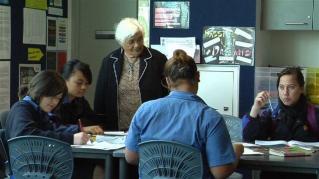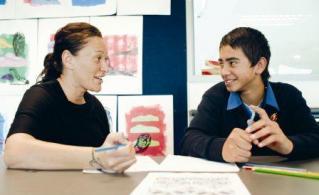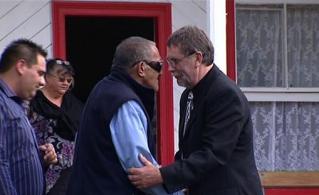Transcript
Narration
Research shows that bringing cultural context into the curriculum affirms the students’ identity, and validates their cultural knowledge and knowledge of their whānau. It provides a relevance and immediacy which motivates students, as Julie McLaughlin at Tolaga Bay Area School found by responding to what she knew was important to her students.
In doing this the teacher also re-positions herself as a learner. This is an example of Ako, where everyone in the classroom is a learner.
Julie McLaughlin – Teacher, Tolaga Bay Area School
About half way through the first term I decided to change one of my units – and that was the research one – and I was going to do coal mining. But then in one of my PE lessons with one of the junior classes, I told them to take their watches off and take their jewellery off. And a couple of them said "No" – we weren’t going to take their pounamu necklaces off. And I asked them why and they explained that it’s very significant to them. It was passed down from great-grandmother down the family line. And I thought about it and I looked in my senior class, which is the class that I was doing the assignment with, and I looked at a couple of them and they had the necklaces on as well. So I decided to change the unit from coal, which didn’t really relate to them, to the pounamu and how it’s extracted and what it’s made of. So it was something that they were familiar with and something that meant something to them.
Nori Parata – Principal Tolaga Bay Area School
It also meant that their parents and whānau had cultural knowledge that was appropriate and was going to be seen and reinforced as valid by the teacher and by the assessment. And so their whānau were able to participate in that as well.
Aniwa Kingi – Student, Tolaga Bay Area School
Our family helped a lot. They told us the different types – there are heaps of types - and the importance about them.
Ngahui Ngata – Chair BOT , Tolaga Bay Area School
There was a body of knowledge, I suppose, that I knew that Kuranui kids could access, and that "Māori knowledge", or their knowledge, would be given some validation in the mainstream context. I was more pleased, I suppose, that Julie was acknowledging that it would be an appropriate and relevant topic that could include every child.
Nori Parata
That project did spill over into the wider school. And students who had been wearing pounamu since they were born, but not necessarily understanding why they had been wearing them, suddenly became more aware and wanted to find out more.
Dexter Waru – Student, Tolaga Bay Area School
We can go up and see someone and go: "Oh, I know what that type of greenstone is".
Hana Parata – Student, Tolaga Bay Area School
I think it’s better that it was about pounamu because of pounamu’s significance to our country.
Julie McLaughlin
I would do it again in a second. It’s quite good to change it so you get the better grades because they are interested in the topic.
Wally Penetito – Lecturer, Victoria University of Wellington
Generally speaking, when teachers do things which have a label "Māori" on them, they're considered to be doing cultural things. Well I think one thing we need to clear up from the beginning is that everything that they do is cultural. It mightn’t be Māori cultural, but it will be cultural. In other words it belongs to some community of values, some institutions. And the language that are being used conveys certain messages.
Mason Durie – Deputy Vice Chancellor Māori, Massey University
If education is going to be meaningful, people have got to be able to interpret it from their own world views. And that essentially means that culture is integral to learning. If you leave a cultural perspective out of the learning process, then its cerebral learning, which doesn’t touch the heart.
Wally Penetito
You could introduce the New Zealand context at any time - New Zealand history, New Zealand landscapes, New Zealand plant life, whatever - nobody needs to make excuses for doing that. The risks are ones where a society grows up knowing about the world without knowing about its own world.
Keriana Tawhiwhirangi – Director, Principals’ Development Association
To me it’s part of what makes us a Kiwi country. It’s part of what every Kiwi teacher should be thinking about. Not "Should I do it?", but "How can I do it?". And to get up after they may have been knocked once or twice, because that’s what we're putting into our students: "Take risks – you might fall over but we are there to help you". And I’m sure, if they do their homework and that research in terms of that, they will not only find key people - they will find key people who believe in them and in their journey, and will be there to support them regardless.
Nori Parata
When Julie emailed: "Is it worth her applying?", you know she was saying, “I’m a Pakeha, have I got anything to offer... in helping you achieve the goals that you want to achieve?”. And I emailed back and said: “Absolutely it is worth you applying”.
Julie McLaughlin
Well at the interviews I sort of went through and said everything I could do. And they said: “Any weaknesses?”, and I said: “Yes, I’m very willing to try and learn new things, that’s why I want to come here, but I have absolutely no clue about how to say Māori names, how to pronounce them. I know a little bit about the culture and stuff, but I’m not... that would be an area that I’d need professional development on”.
Jasmine Leach – BOT Member, Kuranui, Tolaga Bay Area School
She’s passionate about kids and she’s passionate about achievement, and she sets high expectations for all of them, without exception.
Nori Parata
One of the areas of expertise that this community does have is in its own culture, in its own tikanga and in its own reo. One of the things that we reinforce for the staff is that: “You may not know – there are people in this community who do know. They are willing to share it with you if you are going to be genuine in your use of it.





